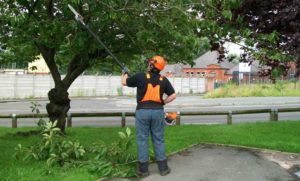Landscaping: How to Avoid Hidden Hazards
Landscaping is a job that many DIYers who love to work outdoors take upon themselves. There are obvious dangers to this kind of work when operating heavy automatic machinery (rototillers, mowers, weed wackers, Bobcats, tractors, trenchers, and blowers) that we will cover below. Many creative home improvement enthusiasts and even some professional contractors are unaware of the potential hazards of landscaping.
“An Ounce of Prevention is Worth a Pound of Cure.” (Benjamin Franklin)

Top 8 Landscaping Dangers and Preventive Measures:
- Learn how to use your equipment before working with it. Study the user manual, read the safety instructions carefully, and if possible, ask a fully-trained professional to show you how to use the tool for the first time. Do not attempt to repair equipment that is malfunctioning or jammed. Numerous tragic cases of injuries that happen while operating various tools are reported every year. It is important to keep tools in excellent working condition - sharp and clean – to help prevent repetitive stress injuries. After the landscaping work is done, make sure that your equipment is properly cleaned and ready for your next landscaping job. Do not leave machinery unattended. Properly secure and store any equipment, chemicals, or materials that will be left at the site.
- Wearing PPE is required for landscaping work: protective gloves and glasses, ear muffs or ear plugs, face masks and shields, respirators, helmets, non-slip sturdy shoes, and the appropriate workwear – long sleeve loose-fitting shirts and long pants. Last but not least: absolutely no jewelry, as it may get caught in the machinery while performing the work.
- Wear high-visibility clothing to be easily spotted on the street: vehicle accidents are the leading cause of fatal incidents among landscapers. Exposure to extreme temperatures may result in heat stress, so dress according to the weather conditions. Take the shade with you by wearing the Evaporative Cooling Ranger Hat. To protect yourself against the harmful ultraviolet radiation, use a sunscreen lotion with at least SPF30, wear sunglasses that block 99-100% UVA and UVB radiation. Limit your sun exposure time by taking frequent breaks and staying in the shadow. Drink plenty of water and avoid caffeine to prevent heat cramps and exhaustion. In wet conditions, don’t forget to put on the appropriate rainwear.
- Proper eye and respiratory protective equipment - goggles and respirators - must be used while working with toxic chemicals, such as Roundup and other glyphosate-containing herbicides for weed and grass control, that are very dangerous. Clean water supply and some space where workers can wash in the event of chemical splashes should be located in close proximity to working areas where chemicals are handled. One more safety reminder: chemicals must be transported properly via truck or trailer in special containers.
- Prevent falls from ladders by making sure the ladder is placed on a stable, leveled surface, and by not loading it beyond the maximum load capacity stated in the manufacturer’s brochure. Make sure the top and the bottom of the ladder are free of tools or any debris and use ladder safety and fall safety systems for extra protection.
- The main source of injury for tree care professionals and the DIY-trimmers is that tree branches fall in an unexpected direction. Falls from high trees, ladders or aerial lifts are extremely dangerous and should be prevented with Fall Safety equipment. In addition, electrocution due to tree trimming performed near utility lines, or improper handling of outdoor lighting systems can result in major injury or death. When working near the electrical lines, wear Arc Flash Rated clothing and avoid the danger of electrical shock and electrocution by remaining at least 10 feet from electric lines to perform tree care operations, or contact the utility company to de-energize and ground the lines. Do not operate electrical equipment in humid conditions, and use special cut–resistant rubber gloves and boots.
- Other easily-preventable dangers include allergic reaction to plants or insect bites and stings, Histoplasmosis from bird droppings, Hantavirus from mouse droppings. Wearing the appropriate PPE will completely eliminate these risks. Wearing HazMat suit, gloves and booties will protect you from exposure to the hazardous substances.
- To protect from fire danger, wear flame resistant clothes, and make sure your electrical equipment does not cause a fire by keeping it in perfect working condition, especially in severe drought conditions and in high fire risk environments.
Be aware of hidden dangers in your work environment at all times, and be safe by following Landscaping and Horticultural Safety Guidelines and best practices provided by OSHA.
If you have questions or need help finding the right landscaping safety equipment, please feel free to call us at 800-829-9580, or visit us online at pksafety.com.
Recent Posts
-
Promoting Safety: National Work Zone Awareness Week is April 15-19, 2024
Each year, the National Work Zone Awareness Week (NWZAW) places the spotlight on the importance o …Apr 11th 2024 -
Understanding 4 Gas Monitors: How They Work & Why They Are Important
In today’s increasingly dynamic industrial landscape, 4 gas monitors have emerged as critical com …Apr 8th 2024 -
April Showers Require Workers to Wear Hi-Vis Safety Rain Gear
While April showers bring May flowers, they also bring challenges, particularly for those working …Apr 1st 2024





